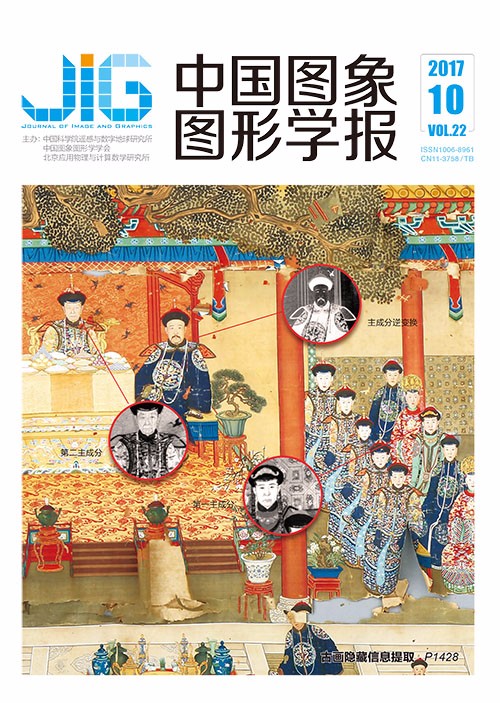
自适应双向保带宽对数变换及低照度图像增强
摘 要
目的 在低照度环境下,由于受图像采集设备的限制,导致获取到的图像往往亮度低、对比度差。针对这一问题,提出一种自适应双向保带宽对数变换的增强算法。方法 首先通过标准化变换将低照度图像处理成标准化图像,然后根据标准化图像的平均亮度进行自适应双向保带宽对数变换,最后对图像取整输出,从而得到增强后的图像。结果 实验选用LIVE database release2标准库中29幅高质量图像作为参考图像,然后经Photoshop CS5统一处理成低照度图像,使用本文算法对其增强,并与直方图均衡化(HE)、多尺度Retinex增强(MSR)、自然保持的增强算法(NPEA)的结果进行比较。本文算法增强后的图像其整体对比度和亮度在主观上都有较大提高,增强效果优于其他3种方法;同时,本文算法峰值信噪比(PSNR)和结构相似度(SSIM)客观指标平均值分别为22.75和0.86,明显高于其他3种算法。另外,在算法运行效率方面,本文算法平均运行时间也较短,约为74 ms。结论 本文算法增强后的图像更自然、更符合人眼视觉特性,且算法简单易于实现,运行效率高。该算法广泛适用于背光或光照不均的低照度环境下的图像增强。
关键词
Adaptive bilateral logarithm transformation with bandwidth preserving and low-illumination image enhancement
Mao Dongyue, Xie Zhengxiang, He Xiangqian, Jia Yuanyuan, Zhou Lihua(College of Medical Information, Chongqing Medical University, Chongqing 400016, China) Abstract
Objective In a low-illumination environment,such as in nighttime video surveillance and some special scenes,the limitations of the image acquisition device,non-professional photography,and loss of information in video transmission often results in the acquisition of image with low brightness and poor contrast.Such conditions bring great challenges to image post-processing,such as image recognition,segmentation,and classification.Therefore,enhancing a low-illumination image in the preprocessing step is necessary.The aim of low-illumination image enhancement is to enhance the dark area,suppress the highlighted area,and realize the image clarity.At present,most of the methods are based on Histogram Equalization(HE),Retinex theory,and homomorphic filtering.Particularly,HE can adaptively improve the dynamic range of the image gray scale but it also can lead to unnatural over-enhancement of image contrast;and the merging gray levels cause loss of some details of the image.Retinex-based algorithms can enhance image contrast to a certain extent,but the computational complexity is generally high,the computational speed is slow,and the image color is also easily distorted.The premise of the enhancement algorithm based on homomorphic filter is that the illumination is uniform,so this method is unsuitable for low-illumination images with uneven illumination.Moreover,this method also lacks self-adaptability because the dynamic range depends on the frequency of the filter.Although the logarithmic transform can show more details of the dark area,but it also loses some details of the bright region.The Retinex algorithm and the enhancement algorithm based on homomorphic filter all involve logarithmic transformation,but none of the logarithmic base are specified.Only one-way logarithmic transformation is carried out,which can only improve the image contrast of the dark area.To overcome the shortcomings of the existing algorithms,and inspired by the characteristics of logarithmic transformation,this paper proposes a low-illumination image enhancement algorithm based on adaptive bilateral logarithm transformation with bandwidth preserving.Method The proposed method includes four steps.First,the low-illumination image is transformed into a standardized image by a special gray transformation called the standard transformation,which can stretch the image contrast to some extent.The purpose of image standard transformation is to make the image gray/color spectrum width equal to 256 to preserve full bandwidth.Compared with non-standardized image,the contrast and brightness of standardized image had increased.Standard transformation lays foundation for further image quality optimization.The second step of the algorithm is computation of the Average Luminance(AL) of the standardized image.Then,the adaptive bilateral logarithm transformation with preserved bandwidth is performed according to AL.More concretely,if AL is less than 127.5,reverse logarithm transformation with bandwidth preserving is carried out first,and then the forward logarithm transformation with bandwidth preserving is performed.Otherwise,forward logarithm transformation with bandwidth preserving is carried out,and then the reverse logarithm transformation with bandwidth preserving is performed.Through calculation,the value of logarithmic base is set to 1.021 983 956 89,thus achieving logarithm transformation with bandwidth preserving.Through this step,image details both in dark area and bright area can be displayed.Finally,the image is rounded out to obtain the enhanced image.Result In the experiment,29 high-quality images in the LIVE database release 2 are used as reference images,and then processed into low-illumination images by Photoshop CS5.After that,the proposed algorithm is utilized to enhance these low-illumination images and compared with the enhanced results obtained by HE,Multi-scale Retinex(MSR),and Natural Preserved Enhancement Algorithm(NPEA).Qualitative and quantitative analyses are conducted to evaluate the proposed algorithm.Experimental results show that the overall contrast and brightness of the proposed method are improved subjectively,and the enhancement effect is better compared with the other three enhancement algorithms.Simultaneously,the Peak Signal-to-Noise Ratio(PSNR) and Structure Similarity(SSIM) value obtained by the proposed method is higher than the other three algorithms.The average PSNR and SSIM values obtained by the proposed method is 22.75 dB and 0.86,whereas the average PSNR and SSIM value of the other three method are 16.16 dB and 0.58(HE),15.82 dB,and 0.62(MSR),18.62 dB,and 0.78(NPEA),respectively.In addition,the average running time of the proposed algorithm is relatively short(74 ms);however,the running time of MSR and NPEA are respectively 11.28 s and 11.58 s under the same conditions.Conclusion The proposed method makes up for the defects of retinex algorithm and homomorphic filtering method,which can improve the dark area and bright area contrast of the image at the same time.Consequently,it can enhance the low-illumination image effectively.Moreover,the algorithm can eliminate the halo artifact caused by Retinex,and it does not merge gray levels as HE.The enhanced image is more natural and more consistent with the human visual system.Meanwhile,the proposed algorithm is simple and easy to implement,which can greatly improve the operational efficiency.The proposed method can be widely applied to image enhancement in low-illumination environment under backlight or uneven illumination.However,the limitation of the proposed algorithm is the contrast and brightness of the enhanced image should be further improved.The future work will focus on applying the average luminance transformation to the enhanced image to do further enhancement.In addition,for the sake of further improving the robustness of the algorithm,more tests and verification are required for the nighttime video monitoring field.
Keywords
low illumination image enhancement standard transformation adaptive bilateral logarithm transformation bandwidth preserving
|



 中国图象图形学报 │ 京ICP备05080539号-4 │ 本系统由
中国图象图形学报 │ 京ICP备05080539号-4 │ 本系统由